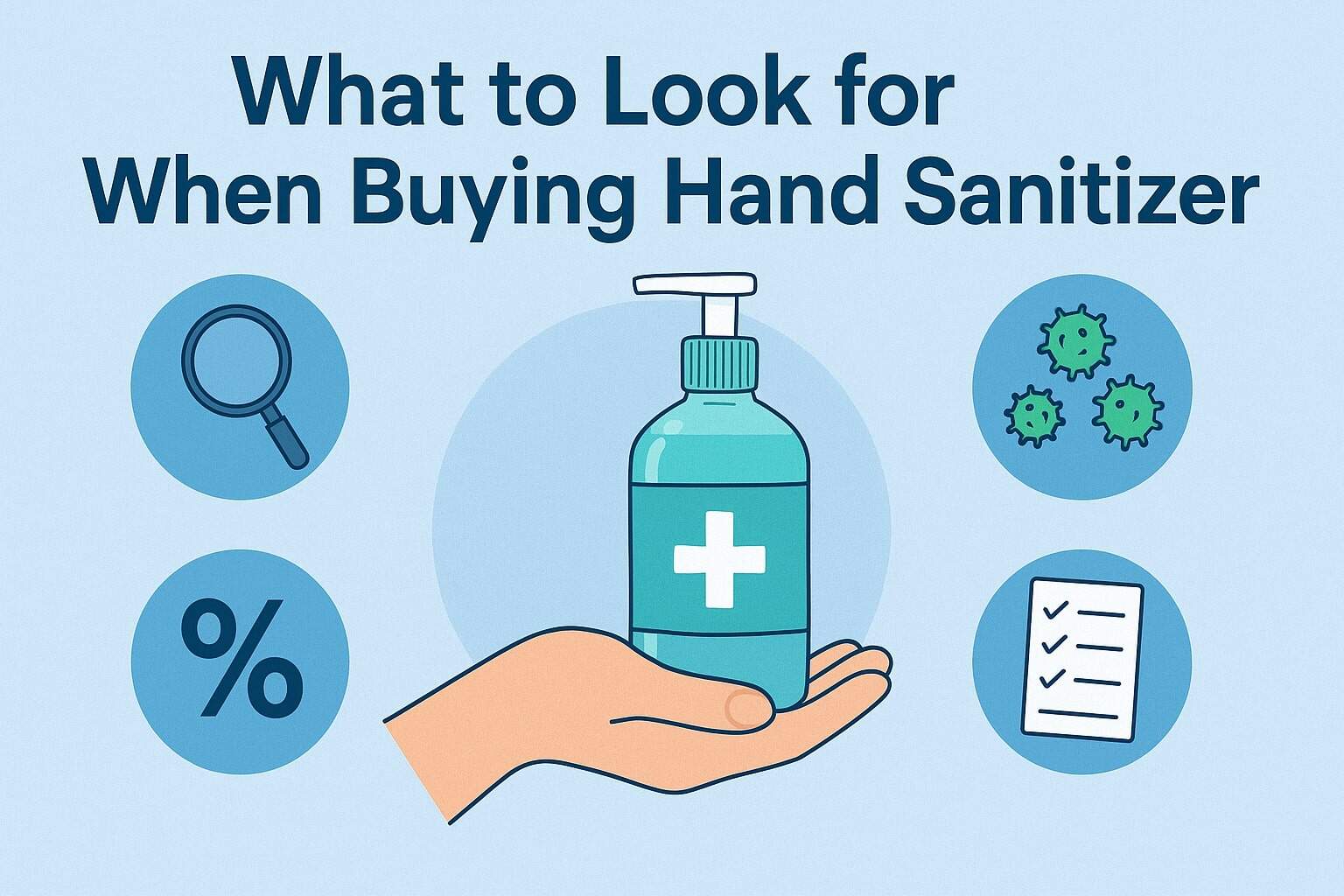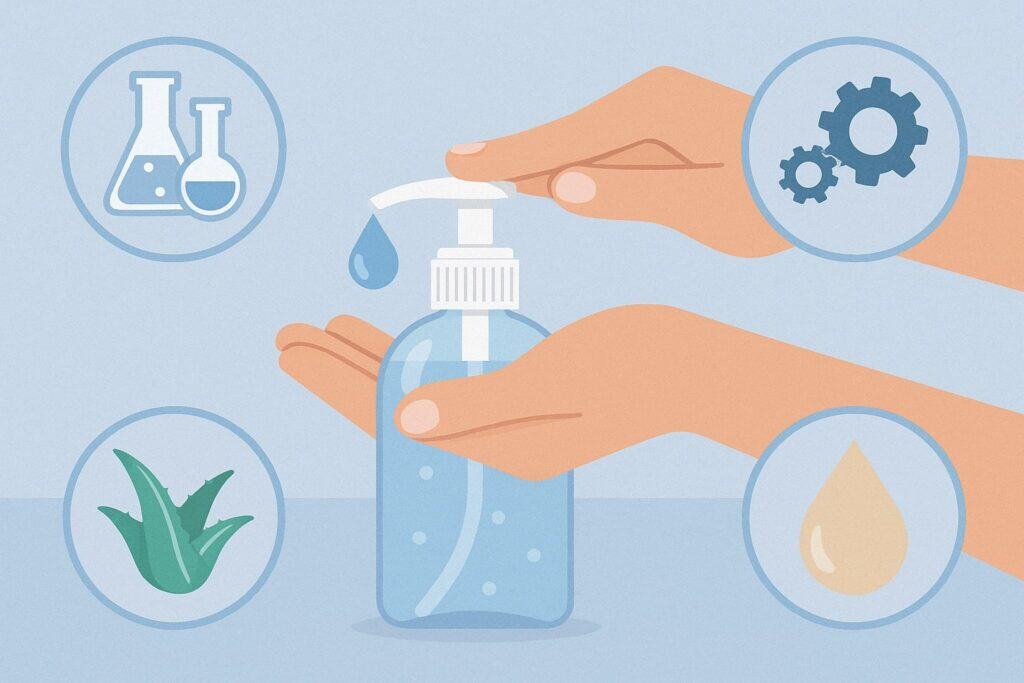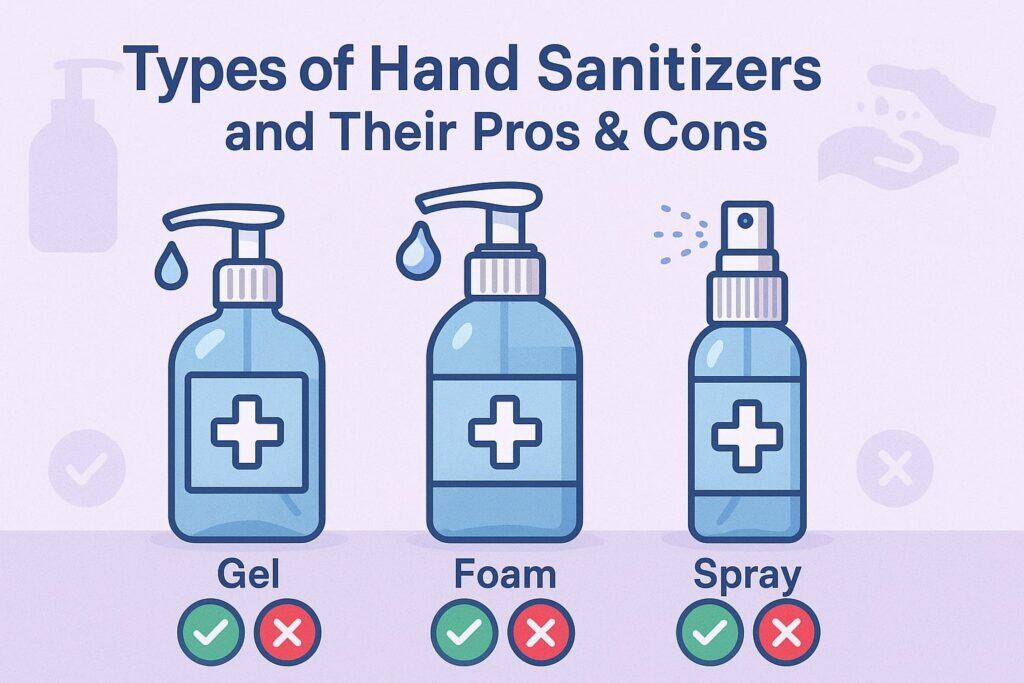
By myhandsanitizershop September 30, 2025
Hand sanitizer has become a household essential, especially after the global pandemic heightened awareness around hygiene and personal protection. While it seems like a simple purchase, choosing the right sanitizer is more complex than grabbing the first bottle you see on the shelf.
Factors such as ingredients, effectiveness, safety, brand reliability, and even the packaging all play crucial roles. In this comprehensive guide, we’ll explore everything you need to know before buying hand sanitizer, so you can make an informed, safe, and effective choice for yourself, your family, or your business.
Understanding Why Hand Sanitizer Matters

Hand sanitizers are more than just convenient alternatives to soap and water—they serve as a frontline defense against infectious diseases in situations where handwashing isn’t possible.
The Centers for Disease Control and Prevention (CDC) recommends alcohol-based sanitizers with at least 60% alcohol because they effectively kill most harmful germs. However, the importance of hand sanitizer goes beyond just personal hygiene.
Sanitizers play a critical role in high-traffic public areas such as hospitals, schools, restaurants, and offices. In healthcare settings, proper use of hand sanitizers can reduce hospital-acquired infections, which are a major concern worldwide.
For travelers, having a portable sanitizer offers peace of mind in airports, public restrooms, and crowded transportation hubs. For families with kids, especially during flu seasons, it adds a protective layer when soap and water aren’t immediately accessible.
Moreover, the significance of sanitizer has economic and psychological implications. Businesses that provide quality sanitizers for employees and customers signal responsibility and care, which builds trust. Individuals carrying sanitizer often feel more secure in social environments, reducing anxiety over germ exposure.
Yet, despite its importance, not all hand sanitizers are created equal. Some are ineffective, while others may contain unsafe or irritating ingredients.
Some products even lack regulatory approval, making it vital to understand what sets a good sanitizer apart. Recognizing these nuances is the first step toward purchasing a product that truly works.
Key Ingredients to Look for in Hand Sanitizer

When shopping for hand sanitizer, the first thing to examine is the ingredient list. The effectiveness and safety of the product largely depend on what goes into it. Here’s a closer look at the most important ingredients:
Alcohol Content
The gold standard for sanitizers is ethyl alcohol (ethanol) or isopropyl alcohol (isopropanol). According to the CDC, the concentration should be between 60% and 95% to be effective against most germs.
Anything below 60% may not kill enough bacteria or viruses to be useful. Conversely, concentrations above 95% may not work as effectively because water is necessary for alcohol to denature proteins in microorganisms.
Moisturizers and Skin Softeners
Frequent sanitizer use can cause dry, cracked skin, especially in cold or dry climates. That’s why many high-quality products include aloe vera, glycerin, or vitamin E to moisturize. These additions help maintain skin health without reducing germ-killing effectiveness.
Avoid Harmful Additives
Some hand sanitizers contain methanol (wood alcohol), which is toxic and unsafe for human use. The FDA has issued warnings against products with methanol. Similarly, avoid sanitizers with excessive artificial fragrances, parabens, or triclosan, as they can irritate skin or disrupt hormones with long-term exposure.
Thickening Agents and Stabilizers
Ingredients like carbomer or hydrogen peroxide (in small amounts) are often included to stabilize the formula or create gel consistency. These are generally safe and improve usability.
Fragrances and Essential Oils
While fragrance makes sanitizer more pleasant, it may cause allergic reactions for sensitive individuals. If you or your family have sensitive skin, opt for fragrance-free formulas.
Essential oils like lavender or tea tree oil are popular, but they should only complement—not replace—alcohol as the active germ-fighting ingredient.
By carefully checking the ingredient label, you can ensure that your sanitizer is both effective and safe for frequent use.
Types of Hand Sanitizers and Their Pros & Cons

Not all hand sanitizers come in the same form. Different formats cater to different preferences and situations. Understanding the pros and cons of each type helps you choose wisely:
Gel Sanitizers
The most common type, gel sanitizers are easy to find and typically contain alcohol plus moisturizers. They spread well across the hands and dry relatively quickly. However, some gels leave a sticky residue, especially low-quality options.
Foam Sanitizers
Foam sanitizers are dispensed as lightweight foam, making them easy to apply and less messy. They often feel gentler on the skin, but sometimes require more product per use, making them less cost-effective in the long run.
Spray Sanitizers
Spray versions are excellent for quick application and double as surface disinfectants for doorknobs, phones, and other frequently touched items. However, sprays can dry skin faster since they usually have a thinner consistency and higher alcohol concentration.
Wipes
Hand sanitizer wipes are convenient for travel, especially when dealing with sticky messes. They clean dirt and germs simultaneously, making them ideal for parents with children. Their downside is single-use waste and limited effectiveness if not saturated properly.
Each type serves a purpose. For everyday pocket use, a gel or spray is practical. For businesses or public areas, foams and dispensers are often preferred. For travel, wipes may be the most versatile. Choosing the right type depends on your lifestyle, environment, and budget.
Packaging, Portability, and Dispensing Options
How hand sanitizer is packaged affects both convenience and hygiene. Packaging determines how often you’ll use it and how practical it is in different settings.
Small travel-size bottles (30–60 ml) are perfect for pockets, purses, and backpacks. They encourage frequent use and are ideal for on-the-go lifestyles. Medium-size bottles (100–250 ml) are suited for personal desks or car compartments. Larger bottles (500 ml or more) are best for households, classrooms, and offices.
Dispensing mechanisms also matter. Flip caps and pump dispensers are user-friendly, while touchless dispensers in public areas enhance hygiene by reducing contact. Refillable bottles promote sustainability and lower long-term costs.
Additionally, consider packaging material. Some plastics can degrade when exposed to high alcohol concentrations. Look for bottles labeled as alcohol-resistant to avoid leaks. If sustainability is important to you, check for recyclable packaging or bulk refill options to reduce waste.
Packaging might seem like a minor detail, but it significantly impacts usability. For example, children are more likely to use sanitizer if it’s in a fun, brightly colored bottle. Businesses may prefer branded dispensers that reflect professionalism. Ultimately, good packaging makes hand sanitizing easier and more consistent.
Safety and Regulatory Standards
Before buying hand sanitizer, it’s critical to verify that the product meets safety and regulatory requirements. Reputable sanitizers typically display certifications or compliance with recognized standards.
In the United States, the Food and Drug Administration (FDA) regulates over-the-counter sanitizers. Products should clearly list active ingredients, concentrations, and warnings. If a product doesn’t list alcohol content, it’s a red flag.
The World Health Organization (WHO) provides recommended formulations for effective sanitizers. Many trusted brands follow these formulations to ensure global safety standards.
For businesses, purchasing sanitizers that meet OSHA (Occupational Safety and Health Administration) and CDC guidelines is essential.
Checking whether a product has been recalled is also important. The FDA regularly updates lists of unsafe hand sanitizers, particularly those containing methanol or substandard alcohol levels. Consumers should avoid unbranded or suspiciously cheap products, as these often bypass regulations.
In international markets, look for certifications such as CE marking in Europe or Health Canada approval. These signals confirm that the sanitizer has undergone rigorous safety testing.
Being mindful of regulatory compliance protects you from purchasing unsafe or ineffective products. It also ensures peace of mind, knowing that what you’re using genuinely contributes to your health and safety.
Common Mistakes People Make When Buying Hand Sanitizer
Despite its widespread use, many people make mistakes when selecting a sanitizer. These missteps often result in poor protection, wasted money, or skin irritation. Some common mistakes include:
- Choosing low-alcohol formulas that don’t meet CDC recommendations.
- Prioritizing scent over effectiveness, buying pleasant-smelling but weak sanitizers.
- Falling for misleading marketing claims like “all-natural” sanitizers without sufficient alcohol content.
- Ignoring expiration dates, which reduces effectiveness over time.
- Overlooking packaging convenience, leading to inconsistent use.
- Not considering skin sensitivity, which can cause dryness, rashes, or allergies.
- Buying from unreliable sources, especially during shortages, which increases the risk of counterfeit products.
By avoiding these pitfalls, you can ensure that your sanitizer choice truly protects your health and provides long-term value.
FAQs
Q.1: Is hand sanitizer as effective as washing hands with soap and water?
Answer: Hand sanitizers are very effective against many germs but not all. Soap and water remain the gold standard, especially for visibly dirty or greasy hands. Sanitizers are a convenient backup when soap isn’t available, but they should not entirely replace handwashing.
Soap physically removes dirt and microbes, while sanitizer mainly kills germs present on the skin. Ideally, use sanitizer when outside and wash hands thoroughly when you return home.
Q.2: Can children safely use hand sanitizer?
Answer: Yes, but with supervision. Children are more sensitive to alcohol exposure and may accidentally ingest sanitizer, which is dangerous. Parents should ensure kids use only a pea-sized amount and rub thoroughly until dry.
For schools, installing wall-mounted dispensers reduces risks by controlling the amount dispensed. It’s also wise to choose fragrance-free and moisturizing formulas for children’s sensitive skin.
Q.3: Do alcohol-free sanitizers work?
Answer: Some alcohol-free sanitizers use benzalkonium chloride or other antimicrobial agents. While they may provide limited protection, they aren’t as effective as alcohol-based sanitizers against certain viruses, including COVID-19.
If you choose alcohol-free options due to skin sensitivity, use them only as a supplementary measure and prioritize soap and water whenever possible.
Q.4: How do I know if my hand sanitizer is expired?
Answer: Check the packaging for an expiration date. Over time, alcohol evaporates, reducing effectiveness. Expired sanitizers may still provide some protection, but they won’t meet recommended germ-killing standards. If a sanitizer smells weaker, feels watery, or has unusual separation, it’s best to replace it with a fresh product.
Q.5: Can I make hand sanitizer at home?
Answer: Yes, but it’s risky. WHO provides a formulation using isopropyl alcohol, hydrogen peroxide, glycerol, and distilled water. However, improper mixing or incorrect alcohol concentration can make the product ineffective or unsafe.
Homemade sanitizers also lack stabilizers that ensure long-term potency. Whenever possible, it’s safer to buy from trusted manufacturers who meet regulatory standards.
Conclusion
Hand sanitizer is a modern necessity, but choosing the right one requires careful consideration. From checking alcohol content and ingredients to evaluating packaging, safety, and certifications, every detail matters. A good sanitizer balances effectiveness with skin safety, convenience, and regulatory compliance.
Avoiding common mistakes—like choosing weak or unverified products—ensures you’re genuinely protecting yourself and your family. Whether for home use, travel, school, or workplace settings, investing in the right hand sanitizer offers both peace of mind and practical protection.
At the end of the day, sanitizer should complement—not replace—proper handwashing habits. When used wisely, it becomes an invaluable tool in maintaining hygiene, preventing illness, and supporting overall public health.